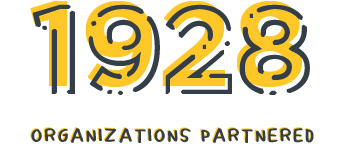
OUR ORGANIZATION AT A GLANCE
OUR NONTRADITIONAL STRUCTURE AND IMPACT BY THE NUMBERS
WE ARE THE WORK
Over the last decade, we’ve changed significantly as an organization. We’ve moved our home base from India to Ohio. We’ve shifted from designing products and services to designing processes and systems. We’ve grown from a team of two to a team of twelve (and then some). And we’ve rearranged from a traditional hierarchical structure to a self-organized model based on deep trust with one another.
We have come to view this nonlinear, unplanned evolution of our model as vital to the health of the work.
Allowing our future to emerge — instead of trying to control it — has taught our team to embrace this constant change as a source of life.
As we work towards disrupting systems of oppression, we recognize that we must also disrupt our own patterns.
"SELF-ORGANIZATION IS NOT A STARTLING NEW FEATURE OF THE WORLD. IT IS THE WAY THE WORLD HAS CREATED ITSELF FOR BILLIONS OF YEARS. IN ALL OF HUMAN ACTIVITY, SELF-ORGANIZATION IS HOW WE BEGIN. IT IS WHAT WHAT WE DO UNTIL WE INTERFERE WITH THE PROCESS AND TRY TO CONTROL ONE ANOTHER."
- Margaret J. Wheatley and Myron Kellner-Rogers, A Simpler Way
We have learned that healthy change with our partners comes from a healthy root system within ourselves. Modeling the world we want to see within our own organization brings us closer to our own moral compass. It also helps us test new ways to work that inform our projects. We were able to ask ourselves,
"HOW CAN WE SCALE BY GROWING DEEPER IN OUR WORK AND IMPACT? HOW CAN WE INVEST MORE IN THIS COMMUNITY AND OUR STAFF? "
Once we decided to embrace change from this new perspective, we could focus on what was actually needed to support our staff, and in turn, the communities impacted by our projects. We rejected the commonly held belief that nonprofits should have a low overhead rate (less than 20%). Instead, we invested in our team.
We chose to pay more than living wages; we invested in our teams’ learning to strengthen the quality of our work. And we invested our time deepening our understanding of systemic challenges facing our communities.
FIVE WAYS DI HAS EMBRACED CHANGE
1. Complex systems change requires a holistic approach. So we assembled a multidisciplinary team of researchers, designers, educators, organizers, and strategists who work together on each project.
2. Facing inequity and complex social changes can make us tired, overstretched, traumatized, and worn down. So we moved to a four-day workweek to give ourselves time to breathe, process, and just live.
3. We recognize the harm caused by scarcity mindsets. So we make decisions based on trust and abundance with one another.
4. Strategic plans and static evaluative models limit our ability to adapt quickly in the face of complexity. So we designed a flexible work model that allows us to continually innovate on what we are doing without the need for top-down approval.
5. Our team is made up of trustworthy, intelligent humans. So we designed a decentralized model so that all members of our team hold power in the organization and play a core role envisioning our future.
DESIGN IMPACT'S STAFF-LED OPERATIONS SYSTEM
In lieu of a strategic plan, Design Impact’s squad system allows members of the team to hold “roles” within each squad that are constantly changing and evolving as the work requires. The organization’s strategy and work is run entirely through these seven squads. This model of decentralized power allows each squad to determine its own way of working, its own strategy, and adapt to organizational and project needs as they arise. This model is inspired by other decentralized decision-making organizational structures including holacracy and matrix models.

WHAT IF POWER WASN'T A ZERO SUM GAME? WHAT IF WE COULD CREATE ORGANIZATIONAL STRUCTURE AND PRACTICES THAT DIDN'T NEED EMPOWERMENT BECAUSE, BY DESIGN, EVERYBODY WAS POWERFUL AND NOBODY WAS POWERLESS?
- Frédéric Laloux, Reinventing Organizations
OUR IMPACT BY THE NUMBERS (2009-2019)
in new mindsets and methods that drive social change through creativity and inclusion

engaged in our work who generated ideas and personal stories, and co-designed with us to test and implement ideas

directly affected by the problems being solved who shared their stories, brainstormed solutions, and tested ideas

with us to create social change

Over the decade, we have partnered with:
19,007 TOTAL PEOPLE
1,928 TOTAL ORGANIZATIONS
READ OUR 2018 FINANCIAL REPORT HERE
